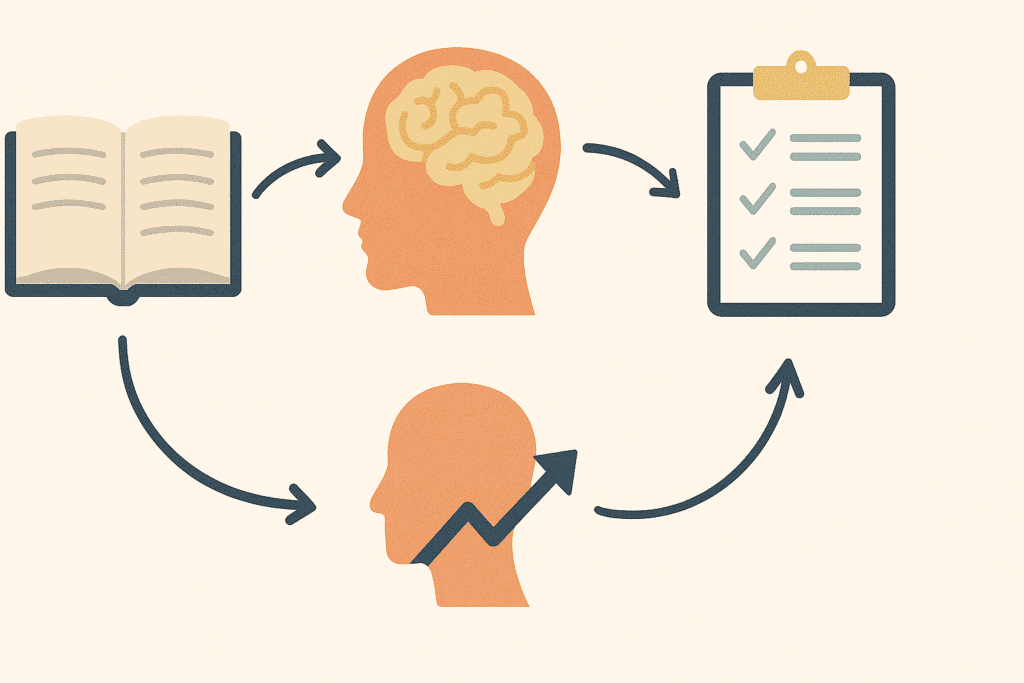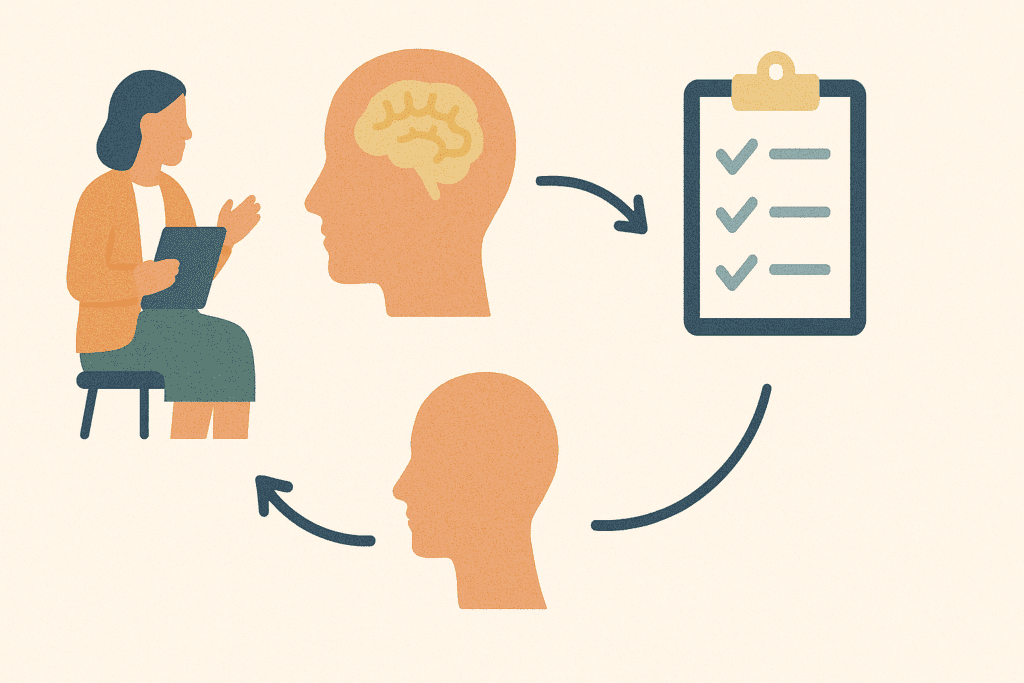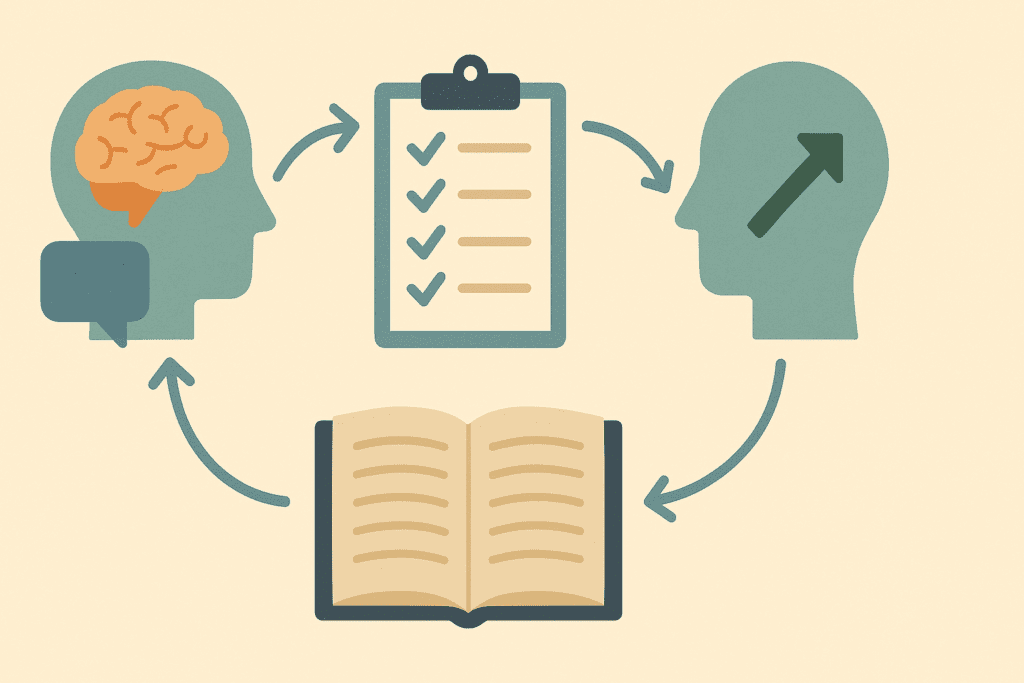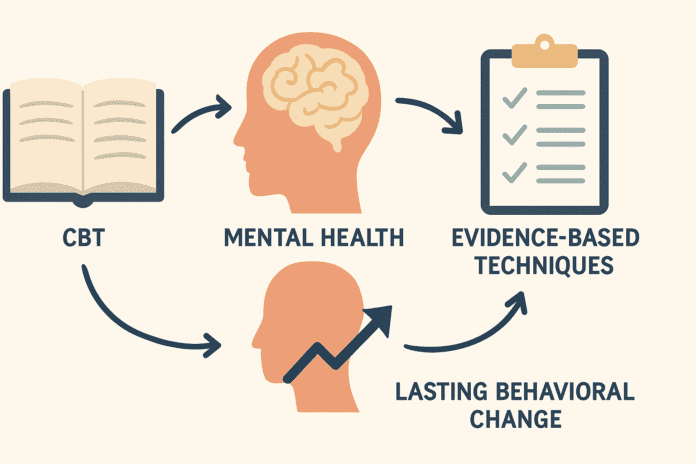In the evolving landscape of mental health care, cognitive behavioral therapy (CBT) has emerged as one of the most effective, evidence-based approaches to psychological treatment. Its enduring relevance stems from its practical orientation, empirical foundation, and adaptability to diverse populations and conditions. The principles of CBT therapy are deeply rooted in both the cognitive model and behavioral approach to psychotherapy, blending theory and technique to produce real-world outcomes. This article explores the theoretical underpinnings, key concepts, and therapeutic mechanisms of CBT, shedding light on how these elements collectively foster mental wellness and sustained behavioral change.
You may also like: How Does CBT Work to Improve Relationships and Communication? Science-Backed Techniques for Getting Along with Others
Understanding the Cognitive Model: The Foundation of CBT
At the heart of CBT lies the cognitive model, a framework that posits our thoughts significantly influence our emotions and behaviors. Rather than viewing emotional responses as automatic reactions to external events, the cognitive model suggests that it is our interpretations—our internal narratives—that shape how we feel and act. This paradigm shift empowers individuals to challenge maladaptive beliefs and reframe distorted thinking patterns that perpetuate psychological distress.
The cognitive model of behavior is not merely an abstract construct; it has been empirically validated across numerous clinical populations. By recognizing the relationship between cognition, emotion, and behavior, clients gain the tools to identify and disrupt harmful cycles. For instance, a person struggling with social anxiety may harbor automatic thoughts such as “I’m going to embarrass myself,” leading to avoidance behaviors and intensified anxiety. Through CBT, such individuals learn to evaluate the evidence for and against these beliefs, gradually building confidence and reducing fear-based behaviors.
The application of the cognitive model CBT framework enables clinicians to collaboratively explore clients’ belief systems and implement tailored interventions. Whether addressing depression, anxiety disorders, or post-traumatic stress, the cognitive model remains a cornerstone of effective treatment planning. Its adaptability across a spectrum of issues underscores its theoretical robustness and clinical utility.
Integrating Behavioral Science: The Cognitive and Behavioral Theory in Action
While cognitive restructuring forms a central pillar of CBT, its effectiveness is magnified when paired with behavioral strategies. Cognitive and behavioral theory, taken together, reflects a comprehensive understanding of human functioning, combining insights from learning theory, cognitive psychology, and clinical practice. The behavioral components of CBT emphasize the role of reinforcement, conditioning, and environmental influences on behavior.
This integrated perspective is particularly valuable in treating behavioral disorders, where modifying actions can lead to profound psychological shifts. Exposure therapy, behavioral activation, and skills training are a few examples of how CBT utilizes the behavioral approach to psychotherapy. These interventions target the external expressions of internal distress, reinforcing adaptive patterns through repeated practice.
For example, in treating obsessive-compulsive disorder, exposure and response prevention (ERP) helps clients confront feared stimuli while refraining from compulsive rituals. This behavioral strategy, grounded in both learning principles and cognitive restructuring, exemplifies how cognitive and behavioral theory work synergistically. The deliberate pairing of thought modification with behavioral experimentation enhances both insight and transformation.
Key Concepts and Tenets of Cognitive Behavioral Therapy
A deeper understanding of CBT requires familiarity with its key concepts and theoretical assumptions. Among the core tenets of CBT is the belief that psychological problems are often maintained by distorted thinking and unhelpful behavior patterns. This aligns with the assumptions of CBT, which posit that cognition mediates between stimulus and response. In other words, how we interpret an event determines how we feel and act.
Another foundational element is the emphasis on present-focused work. While past experiences are acknowledged, CBT maintains that current thoughts and behaviors are the most accessible targets for change. This principle reflects the pragmatic orientation of the therapy, making it particularly suitable for individuals seeking concrete, actionable solutions.
The structured, time-limited nature of CBT is another hallmark of the approach. Sessions typically follow a consistent format, including agenda setting, review of homework, and collaborative planning. This structure promotes efficiency and accountability, reinforcing the therapeutic alliance and maximizing outcomes.
Furthermore, CBT is inherently skill-based. Clients are not passive recipients of insight but active participants in their own recovery. They are encouraged to engage in experiments, monitor thoughts, and practice new behaviors between sessions. This emphasis on skill acquisition and self-efficacy is consistent with the elements of cognitive behavioral therapy, fostering resilience and long-term improvement.
Exploring CBT Components: Techniques That Transform Thought and Behavior
CBT encompasses a variety of components, each designed to address specific aspects of psychological functioning. These components include cognitive restructuring, behavioral interventions, psychoeducation, and skills training. Together, they constitute a comprehensive toolkit for promoting psychological well-being.
Cognitive restructuring involves identifying, challenging, and replacing irrational or maladaptive thoughts. This technique draws on the cognitive model CBT framework, encouraging clients to recognize cognitive distortions such as catastrophizing, black-and-white thinking, or mind reading. By analyzing evidence and generating alternative interpretations, clients develop a more balanced and realistic outlook.
Behavioral interventions, another crucial CBT component, focus on changing observable actions that contribute to distress. Techniques such as exposure, activity scheduling, and behavioral experiments allow clients to confront fears, overcome avoidance, and build mastery. These interventions are grounded in the behavioral approach to psychotherapy and are particularly effective in treating anxiety disorders, phobias, and depression.
Psychoeducation provides clients with a foundational understanding of cognitive behavioral therapy terminology, helping them grasp the rationale behind interventions. By demystifying psychological concepts, psychoeducation empowers clients to take ownership of their recovery. This aspect of CBT reinforces the tenets of cognitive behavioral therapy, promoting transparency and collaboration.
Skills training is yet another component of CBT that enhances clients’ coping capacities. Assertiveness training, problem-solving techniques, and emotional regulation strategies are commonly taught to improve interpersonal functioning and stress management. These tools, integrated into the broader CBT framework, contribute to lasting behavioral change.
The Role of CBT Assessment in Personalized Treatment Planning
A critical yet sometimes underappreciated aspect of CBT is the assessment process. A thorough CBT assessment informs the development of an individualized treatment plan, ensuring that interventions align with the client’s unique needs and goals. This process involves collecting data through interviews, standardized measures, self-monitoring, and behavioral observations.
CBT assessment is not a one-time event but an ongoing process. It begins with a comprehensive evaluation of the presenting problem, functional impairments, and maintaining factors. From there, clinicians generate a working hypothesis based on the cognitive model of behavior, identifying key cognitions, emotions, and behaviors that sustain the issue.
As therapy progresses, continuous assessment allows for the refinement of hypotheses and interventions. Clients may complete thought records, mood logs, or behavioral diaries to track their experiences in real time. This data informs the therapeutic process, highlighting patterns and guiding strategic adjustments.
Incorporating standardized CBT terms into the assessment process facilitates clear communication between clinicians and enhances treatment fidelity. Familiarity with cognitive behavioral therapy terms ensures that practitioners and clients share a common language, promoting clarity and engagement. The use of well-defined terminology also supports research and quality assurance within clinical settings.
Ultimately, effective CBT assessment exemplifies the principles of CBT therapy by grounding treatment in empirical observation, collaborative formulation, and ongoing evaluation. It is a dynamic process that aligns theory with practice, ensuring that therapy remains responsive, targeted, and effective.

Examining the Assumptions of Cognitive Behavioral Therapy
Understanding the assumptions of cognitive behavioral therapy helps clarify why it is such a powerful and versatile tool for mental health intervention. At its core, CBT assumes that individuals can learn to identify and modify maladaptive thoughts and behaviors, leading to improved emotional regulation and functioning. This optimistic view of human potential is both empowering and grounded in empirical evidence.
One of the primary assumptions of CBT is that cognition plays a central role in the development and maintenance of emotional disorders. This is supported by a substantial body of research showing that negative thought patterns—such as hopelessness, self-criticism, and catastrophizing—are closely linked to conditions like depression and anxiety. CBT posits that by altering these thought patterns, individuals can experience measurable improvements in mood and behavior.
Another important assumption is that psychological problems are learned and, therefore, can be unlearned. This aligns with the cognitive and behavioral theory that underpins CBT, emphasizing the role of environmental contingencies, reinforcement, and observational learning. Therapy becomes a process of relearning—of replacing unhelpful patterns with adaptive alternatives through guided practice and reinforcement.
CBT also assumes that insight alone is not sufficient for change. While understanding one’s thought patterns is valuable, meaningful progress requires action. This belief underscores the importance of behavioral experiments, skills training, and homework assignments—all elements of cognitive behavioral therapy that translate insight into action.
Finally, CBT assumes that clients are capable of becoming their own therapists. This self-directed approach encourages autonomy and long-term resilience. Through mastery of CBT key techniques, clients learn to apply therapeutic principles outside of sessions, maintaining gains and managing future challenges independently.
Decoding CBT Terminology: Building a Shared Therapeutic Language
To effectively implement CBT, both therapists and clients must be familiar with essential cognitive behavioral therapy terminology. This shared language facilitates understanding, enhances collaboration, and supports the therapeutic alliance. Terms such as “automatic thoughts,” “core beliefs,” “cognitive distortions,” and “behavioral activation” represent fundamental concepts within the CBT framework.
Automatic thoughts are spontaneous, often subconscious ideas that arise in response to situations. They reflect underlying core beliefs and are central to the cognitive model. Recognizing and challenging these thoughts is a key element of CBT, enabling clients to break the cycle of negative emotions and maladaptive behaviors.
Core beliefs are deeply held convictions about the self, others, and the world. These beliefs, often formed early in life, influence how individuals interpret experiences. Negative core beliefs such as “I am unlovable” or “The world is dangerous” can lead to pervasive distress. CBT helps clients identify and modify these beliefs through cognitive restructuring and behavioral experimentation.
Cognitive distortions are systematic errors in thinking that reinforce negative beliefs. Common distortions include overgeneralization, personalization, and emotional reasoning. By learning to recognize these patterns, clients can develop more accurate and constructive ways of thinking.
Behavioral activation involves engaging in meaningful activities to counteract depression and withdrawal. It exemplifies the behavioral approach to psychotherapy and demonstrates how action can influence emotion. Encouraging clients to pursue rewarding experiences supports mood improvement and reinforces adaptive behavior.
Fluency in CBT terms enhances therapy by promoting mutual understanding and consistency. It also supports the dissemination of CBT principles across diverse clinical settings, ensuring that interventions remain grounded in a coherent and evidence-based framework.

Frequently Asked Questions: Principles and Practice of CBT Therapy
What role does cultural background play in applying the cognitive model CBT approach?
Cultural background significantly influences how individuals interpret thoughts, emotions, and behaviors, which is central to the cognitive model CBT framework. While the cognitive model emphasizes identifying and restructuring distorted thinking patterns, it’s essential for practitioners to understand how cultural values, norms, and experiences shape those patterns. For example, collectivist cultures may frame self-worth in terms of familial roles, requiring tailored cognitive restructuring techniques. The cognitive model of behavior must therefore be contextualized to avoid imposing culturally incongruent standards of mental health. Integrating cultural competence into CBT ensures that the cognitive and behavioral theory is both respectful and responsive to clients’ lived experiences.
Can CBT be adapted for clients who struggle with verbal expression or language barriers?
Absolutely. The principles of CBT therapy can be modified to support individuals who experience difficulty with verbal communication, including non-native speakers or clients with neurodiverse profiles. Therapists can employ visual aids, diagrams illustrating the cognitive model, or emotion-tracking charts to enhance accessibility. CBT components like behavioral activation or exposure tasks can be guided more through experiential learning than verbal dialogue. Importantly, using simplified cognitive behavioral therapy terminology or culturally adapted CBT terms allows for clearer understanding without diluting the therapeutic intent. This flexibility aligns with the assumptions of CBT that therapy should be collaborative, inclusive, and adaptive.
How does CBT integrate with other therapeutic modalities without compromising its core tenets?
CBT’s structured framework can be synergistically combined with other modalities such as mindfulness-based stress reduction (MBSR), dialectical behavior therapy (DBT), or acceptance and commitment therapy (ACT) without undermining its foundational tenets. In fact, the tenets of cognitive behavioral therapy—such as the importance of identifying maladaptive cognitions and modifying behavior—can complement the emotional regulation strategies in DBT or the values-driven actions in ACT. Integrative models preserve the cognitive model while expanding the therapeutic toolkit. Moreover, blending modalities can enrich CBT assessment processes by offering a broader understanding of the client’s internal and external influences. Therapists should ensure that CBT principles remain at the core while flexibly incorporating compatible techniques.
What are some emerging digital tools that support CBT implementation?
Technology is increasingly enhancing how clinicians apply CBT principles in both traditional and remote settings. Apps now assist with tracking CBT components such as thought records, mood monitoring, and exposure exercises. Digital platforms that incorporate the cognitive model of behavior through interactive modules are especially useful for reinforcing psychoeducation. Some programs also use AI to suggest cognitive restructuring techniques based on client input, aligning with core CBT terms and exercises. These tools offer new ways to reinforce the elements of cognitive behavioral therapy between sessions. However, it remains critical that these tools be used under professional guidance to ensure they support, rather than substitute, the therapeutic relationship.
How can therapists assess CBT readiness in clients during the initial stages of treatment?
Assessing readiness for CBT involves more than symptom checklists—it requires understanding a client’s willingness and capacity to engage with the cognitive and behavioral theory at a conceptual and practical level. A robust CBT assessment considers the client’s insight into their cognitive patterns, openness to homework, and ability to reflect on internal processes. Therapists might explore whether clients resonate with the assumptions of cognitive behavioral therapy, such as the idea that thoughts influence emotions and actions. Moreover, identifying preferred learning styles can help align specific CBT components, such as whether a client benefits more from written cognitive restructuring or real-world behavioral experiments. Ultimately, gauging readiness ensures that CBT principles are implemented effectively and ethically.
In what ways can CBT support clients with chronic health conditions?
CBT is highly effective in addressing the psychological challenges that accompany chronic illnesses such as diabetes, heart disease, or autoimmune disorders. The cognitive model CBT framework allows patients to examine how catastrophic thinking or health-related anxieties may amplify physical symptoms or hinder self-care. Behavioral interventions can promote adherence to medical regimens through goal-setting and reinforcement, embodying the behavioral approach to psychotherapy. CBT terms such as “illness beliefs” or “self-efficacy” frequently emerge in chronic care adaptations, helping clients reframe their relationship with their condition. This approach also aligns with the principles of CBT therapy that emphasize empowerment, coping strategies, and realistic thinking.
What are common misconceptions about CBT that affect its effectiveness?
One widespread misconception is that CBT is merely about “thinking positively,” which oversimplifies the cognitive model and diminishes the depth of the work involved. In truth, CBT seeks to replace distorted thinking with balanced and evidence-based thoughts—not unrealistic optimism. Another myth is that CBT ignores emotions, when in fact, understanding emotional responses is central to the cognitive model of behavior. Some also believe CBT only addresses surface-level issues, overlooking how the key concepts of CBT delve into deep-seated beliefs and behavioral conditioning. Clarifying these misunderstandings during CBT assessment ensures that clients are better prepared to engage with the therapy’s elements and assumptions.
How do therapists decide which CBT components to prioritize in treatment?
The selection of CBT components is typically guided by the nature of the client’s presenting problem, personal goals, and current functioning. For example, a client with panic disorder may benefit most from behavioral experiments and exposure-based tasks, while someone with rumination issues might focus on cognitive restructuring grounded in the cognitive model. CBT key techniques are also influenced by the outcome of the initial CBT assessment, which highlights the most pressing dysfunctional patterns. Therapists remain flexible while adhering to the tenets of CBT, integrating psychoeducation, behavior tracking, or skills training as needed. This tailored approach ensures that each session advances both the cognitive and behavioral goals outlined in therapy.
How does CBT address relapse prevention and long-term maintenance of progress?
Relapse prevention is a vital focus in the latter stages of CBT, reflecting one of the most practical applications of the cognitive and behavioral theory. Therapists help clients identify early warning signs of cognitive distortions and behavioral regressions, reinforcing awareness and proactive coping. Clients are taught how to use CBT terms and strategies independently, such as continuing to challenge automatic thoughts or maintaining behavior logs. The assumptions of CBT suggest that long-term improvement depends on consistent self-monitoring and adaptive thinking, not just symptom resolution. By internalizing the elements of cognitive behavioral therapy, clients develop a sustainable skillset that supports resilience even after therapy ends.
How can CBT be applied in workplace wellness and organizational settings?
Organizations increasingly utilize CBT principles to enhance employee well-being, reduce burnout, and foster emotional resilience. Group workshops often focus on key concepts of CBT such as managing negative self-talk, regulating stress, and improving interpersonal communication. The behavioral approach to psychotherapy can be applied to workplace challenges through structured interventions like graded task exposure or solution-focused problem-solving. Leaders can be trained in cognitive behavioral therapy terminology to promote a psychologically safe environment. Integrating CBT assessment tools within employee assistance programs also allows for targeted support, aligning organizational goals with employee mental health outcomes in a scalable and evidence-based manner.

Conclusion: Embracing the Principles of CBT Therapy for Meaningful, Lasting Change
The enduring appeal of cognitive behavioral therapy lies in its ability to translate complex psychological theories into accessible, practical strategies that empower individuals to take control of their mental health. By integrating the cognitive model of behavior with behavioral science, CBT offers a nuanced understanding of how thoughts, emotions, and actions are interconnected. Its effectiveness is anchored in its foundational assumptions, clearly defined CBT terms, and a structured approach that includes ongoing assessment, skill development, and collaborative engagement.
As we continue to face rising rates of anxiety, depression, and stress-related disorders, the relevance of CBT principles becomes ever more apparent. The elements of cognitive behavioral therapy are not only scientifically validated but also deeply human, acknowledging the capacity for growth, adaptation, and healing. From understanding the assumptions of cognitive behavioral therapy to implementing the key components of CBT assessment, the framework provides a roadmap for sustainable change.
Whether you are a clinician seeking to enhance therapeutic outcomes, a student exploring the field of mental health, or an individual on a journey toward self-improvement, the principles of CBT therapy offer a powerful, evidence-based foundation for transformation. By mastering the cognitive and behavioral theory behind this approach and embracing its tenets, we can foster resilience, promote psychological well-being, and cultivate a more balanced and fulfilling life.
cognitive restructuring techniques, emotional regulation therapy, psychological resilience strategies, mental health interventions, talk therapy methods, behavioral modification therapy, evidence-based psychotherapy, therapeutic coping skills, mood disorder treatment, managing anxiety naturally, depression therapy techniques, behavioral therapy tools, therapeutic self-awareness, psychological treatment approaches, thought pattern correction, self-help for mental health, emotional wellness programs, managing intrusive thoughts, therapy for stress management, therapeutic behavior change
Further Reading:
The key principles of cognitive behavioural therapy
Cognitive Behavioral Therapy (CBT): What It Is & Techniques
Cognitive Behavior Therapy: Basic Principles
Disclaimer
The information contained in this article is provided for general informational purposes only and is not intended to serve as medical, legal, or professional advice. While Health11News strives to present accurate, up-to-date, and reliable content, no warranty or guarantee, expressed or implied, is made regarding the completeness, accuracy, or adequacy of the information provided. Readers are strongly advised to seek the guidance of a qualified healthcare provider or other relevant professionals before acting on any information contained in this article. Health11News, its authors, editors, and contributors expressly disclaim any liability for any damages, losses, or consequences arising directly or indirectly from the use, interpretation, or reliance on any information presented herein. The views and opinions expressed in this article are those of the author(s) and do not necessarily reflect the official policies or positions of Health11News.


